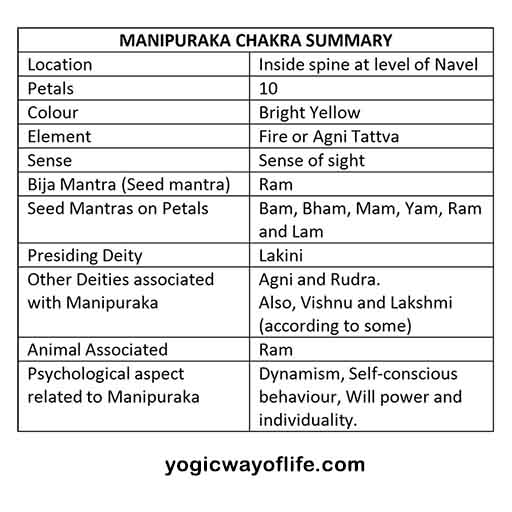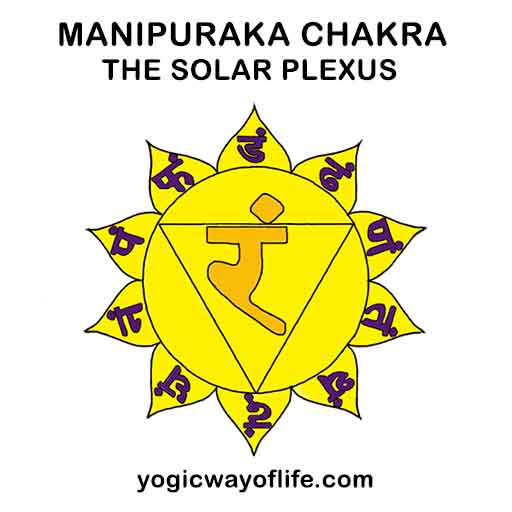Manipura Chakra or the Navel Plexus is the centre for dynamism, energy and the will to achieve goals. In Sanskrit, Mani means jewel, Puri means city and Chakra means a wheel or vortex or energy. Manipura means the city of jewels. According to tantric texts, many Pranic channels meet at this centre, creating a radiating light, shining like a bright jewel. There are seven chakras or plexuses along the spine. Manipuraka is the third plexus from the base. Manipura deals with digestion and absorption and the fire element.
Location of Manipura Chakra
Manipura chakra, also called the solar plexus, is located at the level of the navel inside the spine or Sushumna. This is the actual location. But the navel region can also be considered as a trigger or activation point for Manipura. The chakras are more connected to the pranic body. Manipura chakra is not part of the physical body but does influence the digestive system. It deals with digestion and absorption of food and prana.
Traditional symbolism of Manipura Chakra
In tantra, every chakra is depicted as a flower with many petals. There are many texts that symbolically describe the chakras. The most vivid among them is the Shad Chaka Nirupana, which has been translated to English by Sir John Woodroffe in his book, The Serpent Power.
Manipura Chakra is described as a flower with 10 petals. The petals are bright yellow in colour. On the petals are found the Sanskrit letters – Dam, Dham, Nam, Tam, Tham, Dam, Dham, Nam, Pam and Pham written in the colour of blue lotus.
Inside the pericarp is a fiery red triangle which is the region of Agni, the deity of fire element. Outside the triangle is 3 swastika marks and within it is the Bija of fire, Ram. Agni is seated on a ram and has four arms. In his lap resides god Rudra, three-eyed, vermilion in colour and smeared with ashes. His hands are in the gesture of granting boons and dispelling fear.
Inside the lotus is the presiding deity of Manipura called Lakini sitting on a red lotus. Lakini is dark and radiant, clothed in yellow raiment, decked with ornaments and intoxicated after drinking of nectar.
Seed Mantras associated with Manipura Chakra
Seed Mantras or Bija Mantras are one letter syllabled mantras with hidden power. The mantra for Manipura Chakra is Ram. Practitioners use the repetition of this seed mantra to activate the chakra.
Apart from this, the petals of the chakra also have seed letters associated with it. The petals of Manipura chakra has these 10 letters – Dam, Dham, Nam, Tam, Tham, Dam, Dham, Nam, Pam and Pham written on it. These are also used by practitioners while visualising the chakra.
Presiding Deity of Manipura Chakra
Each chakra has a presiding divinity or deity, also known as Chakradhistadhatri. Goddess Lakini is the presiding deity of Manipura. Lakini is described as of dark complexion, wearing yellow raiment, decked with ornaments, having three faces and has four arms. She is intoxicated after drinking nectar.
Sense Organ connected with Manipura Chakra
In tantra, Manipura Chakra is related to the eyes and the sense of sight.
How to Activate Manipura Chakra?
There are many ways of activating a Chakra or plexus. One way is the use of Bija Mantras (One syllabled sacred sounds). The bija Mantra of Manipura Chakra is Ram. Chanting of the seed syllable Ram can be used to activate Manipura chakra.
Practice of Uddiyana Bandha, Agnisara kriya and Nauli kriya can also activate Manipura.
Apart from this, concentration and meditation on the chakra location and other visualisation techniques can also be used.
Manipura and Chakra Psychology
Each plexus is associated with a certain quality of the mind and the evolution of the person. Manipura is the third chakra in the evolution of man and deals with dynamism, will power and energy. The earlier two chakras, Muladhara and Swadhistana deals with instinctual behaviour, while Manipura deals with conscious behaviour. Earlier chakras deal with quality of Tamas or inertness, crowd-behaviour, lack of individuality, etc. but Manipura deals with quality of Rajas, the active, dynamic principle. At this stage of evolution, the individuality becomes prominent. The ego is manifested which gets fine-tuned and subtler as one progresses to higher centres. One is able to stand out in a crowd and express his/her viewpoints. At this stage, the expression is still selfish. As one progresses to higher centres (especially Anahata Chakra), the expression can become selfless.
Manipura plays an important role in the awakening of the kundalini Shakti. Manipura is the place where Prana (upward flowing pranic energy) and Apana (downward flowing pranic energy) meet. This meeting creates heat, which when directed downwards can activate the kundalini in the muladhara. Because of this, in many traditions, Manipura is considered the seat of kundalini and not Muladhara.


